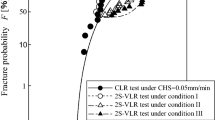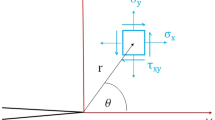Within the framework of the concept used, it is assumed that the destruction of ceramics due to thermal shock is initiated from defects in its structure, i.e., stress concentrators. In this case, the heat resistance of ceramics can be determined using the Weibull theory. For this purpose, a statistically significant sample of alumina ceramic samples was subjected to thermal shock. After that, the sample was mechanically tested and the Weibull parameters of the material were calculated (threshold stress, below which the probability of failure is zero; average strength value; limiting stress, above which the probability of failure is 100%; Weibull modulus). The degree of change of these parameters, in comparison with their values for sampling specimens before the thermal shock, served as an indicator of the thermal shock resistance. This indicator can be considered as a characteristic that determines the resistance of the ceramic structure to the initiation of thermal cracks on existing stress concentrators. The results of determining the thermal stability of alumina samples using the Weibull statistical theory were confirmed by the results of determining their thermal stability by the local thermal shock (LT) method.







Similar content being viewed by others
References
Chemical Technology on Ceramics [in Russian], ed. I. Ya. Guzman, LLC RIF “Stroymaterialy,” Moscow (2005) 336 p.
Yu. N. Vil’k, “Thermal damage resistance of Mg-PSZ ceramics” [in Russian], Ogneupory i Tekhnicheskaya Keramika, No. 10, 12 – 14 (1997).
F. Osterstock and B. Legendre, “A method to compare the thermal shock resistances and the severity of quenching conditions of brittle solids,” J. Phis. III France, No. 7, 561 – 574 (1997).
H. Awaji, S. Honda, and T. Nishikawa, “Thermal shock testing of ceramics by infrared heating,” Int. Ceram. J., No. 5, 55 – 67 (1998).
D. A. Ivanov, “Studying thermal shock resistance of ceramic materials based on their structural sensitivity to a stress concentrator,” Refract. Ind. Ceram., 61(5), 580 – 586 (2021).
R. Danzer, P. Supancic, J. Pascual, and T. Lube, “Fracture statistics of ceramics — Weibull statistics and deviations from Weibull statistics,” Eng. Fract. Mech., No. 74, 2919 – 2932 (2007).
K. Ono, “A simple estimation method of Weibull modulus and verification with strength data,” Appl. Sci., No. 9, 1575 – 1614 (2019).
Z. Bertalan, A. Shekhawat, J. P. Sethua, and S. Zapperi, “Fracture strength: stress concentration, extreme value statistics, and the fate of the Weibull distribution,” Phys. Rev. Appl., No. 2, 034008-1 – 034008-8 (2014).
S.-L. Zhang, Li Teng, and Y. Wei, “Statistical strength of brittle materials with strongly interacted collinear microcracks,” Int. J. Solids Structures, 35(11), 995 – 1008 (1998).
C. A. Klein, “Flexural strength of sapphire: Weibull statistical analysis of stressed area, surface coating, and polishing procedure effects,” J. Appl. Phys., 96(6), 3172 – 3179 (2004).
S.-D. Pang, Z. P. Ba_ant, and J.-L. Le, “Statistics of strength of ceramics: finite weakest-link model and necessity of zero threshold,” Int. J. Fract., No. 154, 131 – 145 (2008).
S. Nadarajah and S. Kotz, “Strength modeling using Weibull distributions,” J. Mech. Sci. Technol., No. 22, 1247 – 1254 (2008).
A. Chaturvedi and K. Taruna, “Estimation and comparison of the stress-strength model with more than two states under Weibull distribution and type II censoring,” Commun. Stat. — Theor. M., 48(3), 537 – 548 (2019).
A. Catangiu, D. N. Ungureanu, and V. Despa, “Data scattering in strength measurement ot steels and glass/epoxy composite,” The Scientific Bulletin of Valahia University Materials and Mechanics, 15(12), 11 – 16 (2017).
F. W. Zok, “On weakest link theory and Weibull statistics,” J. Am. Ceram. Soc., 100(4), 1265 – 1268 (2017).
N. S. Pesotskaya, S. E. Zakiev, V. A. Veretennikov, et al., “Investigation of structural-strength and fractal properties of SHS-corundum at the mesoscopic level” [in Russian], Voprosy Materialovedeniya, No. 1 (29), 406 – 409 (2002).
E. Barbero, J. Fernandez-Saez, and C. Navarro, “Statistical analysis of the mechanical properties of composite materials,” Compos. Part B — Eng., 31(5), 375 – 381 (2000).
J. B. Quinn and G. D. Quinn, “A practical and systematic review ofWeibull statistics for reporting strengths of dental materials,” Dent. Mater., No. 26, 135 – 147 (2010).
N. V. Nikonorov and S. K. Evstrop’ev, Optical Materials Science: Fundamentals of Optical Glass Strength [in Russian], St. Petersburg State University ITMO, St. Petersburg (2009) 102 p.
V. V. Kiryushina, Investigation of Ceramic Materials Using Methods of Probabilistic Analysis in ihe Development and Production of Elements of Aircraft [in Russian], dissertation, Obninsk (2014) 206 p.
R. Ballarini, F. Asce, G. Pisano, and G. Royer-Carfagni, “The lower bound for glass strength and its interpretation with generalized Weibull statistics for structural applications,” J. Eng. Mech., 142(12), 04016100-1 – 04016100-20 (2016).
V. V. Kiryushina, Yu. Yu. Kovaleva, P. A. Stepanov, and P. V. Kovalenko, “Investigation of the influence of the scale factor on the strength properties of polymer composite materials” [in Russian], Izv. VUZ. Yadernaya Energetika, No. 1, 97 – 106 (2019).
V. V. Kiryushina, V. S. Levashov, V. S. Fetisov, and M. Yu. Rusin, “Estimation of the Weibull distribution parameters in the analysis of the strength of ceramic materials for fairings” [in Russian], Mekhanika Kompozitsionnykh Materialov i Konstruktsij, 12(1), 76 – 82 (2006).
V. E. Nizovtsev, O. B. Sil’chenko, M. V. Siluyanova, et al., Vestnik Bryanskogo Gos. Tekhn. Univ., No. 1 (62), 52 – 64 (2018).
A. I. Malkin, F. A. Kulikov-Kostyushko, and T. A. Shumikhin, “Statistical kinetics of quasi-brittle fracture” [in Russian], Zh. Tekh. Fiz., 78(3), 48 – 56 (2008).
Destruction [Russian translation], Vol. 7. Part 1 (inorganic materials), ed. G. Liebowitz, Mir, Moscow (1976) 634 p.
D. A. Ivanov and A. I. Sitnikov, Composite Materials [in Russian], university textbook, Yurayt, Moscow (2019) 253 p.
V. Ya. Shevchenko and S. M. Barinov, Technical Ceramics [in Russian], Nauka, Moscow (1993) 187 p.
S. M. Barinov and V. Ya. Shevchenko, Strength of Technical Ceramics [in Russian], Nauka, Moscow (1996) 159 p.
Author information
Authors and Affiliations
Corresponding author
Additional information
Translated from Novye Ogneupory, No. 12, pp. 42 – 49, December, 2021.
Rights and permissions
Springer Nature or its licensor holds exclusive rights to this article under a publishing agreement with the author(s) or other rightsholder(s); author self-archiving of the accepted manuscript version of this article is solely governed by the terms of such publishing agreement and applicable law.
About this article
Cite this article
Ivanov, D.A. Application of the Statistical Weibull Theory to Estimate the Thermal Shock Resistance of Ceramic Materials. Refract Ind Ceram 62, 699–705 (2022). https://doi.org/10.1007/s11148-022-00665-1
Received:
Published:
Issue Date:
DOI: https://doi.org/10.1007/s11148-022-00665-1




